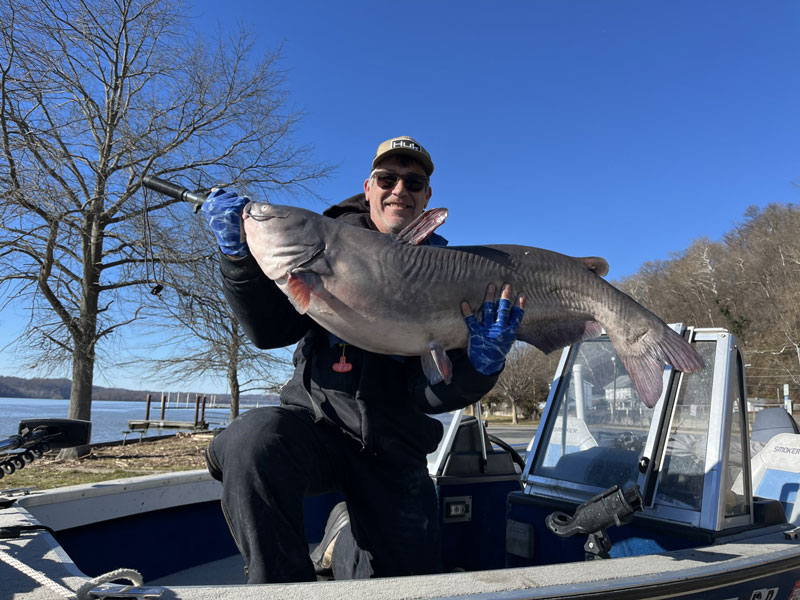We’ve all heard of the big three: blue catfish, flathead catfish, and snakeheads. All of these formerly foreign species can be found throughout Chesapeake Country, all offer intense angling opportunities, and all have loose regulations and high populations — making them an attractive target for fast action and a full dinner plate. Which will you go for? That’s your call. But to help make your endeavor a successful one we’ve wrangled up three top tips for each of these invaders.

Blue Catfish
Blue cats are often thought of as a trophy fish in many areas of Virginia, and the James River in particular is considered a world-class fishery. But since escaping the river’s confines they’ve spread to virtually every Chesapeake tributary and in many areas to the north have become a serious threat to native fish, crabs, and clams. Don’t feel one bit bad about taking home a stringer full of them and remember that this species, unlike some catfish, has a firm white meat that’s excellent on the dinner plate.
- Elevated Attitude - Yes, these are catfish, but blues spend more time roaming upper areas of the water column than most of their cousins. While fishing baits on bottom may account for the bulk of the bites you’ll get, there will be times and situations (depending on factors like what they’re feeding on, currents and tides, or weather) when those resting sitting static will be ignored — yet baits a few feet up get slammed. If you’re not enjoying much action try fishing a bait on a float rig and see if that changes the game.
- Fresh Thinking - Work hard to get fresh bait as opposed to frozen. You’ll notice that frozen baits will sometimes get bumped then rejected, while the fresh stuff gets inhaled. If frozen bait is all you have readily available, come armed with a small rod and a few panfish rigs. Then try to catch a sunfish or perch to cut up on the spot.
- Listen to the Chatter - Another way blues differ from their brethren is that in some scenarios they’ll readily take lures. Chatterbaits in particular tend to draw their attention. Often in tidal creeks these seem to do the trick, and many kayak anglers have discovered that slow-trolling chatters can be deadly.

Flathead Catfish
Flatheads get enormous and put up a battle to rival any river monster, but remember that they inhabit a very specific niche. To find decent numbers stick to rocky riverine areas and fresher venues than you would for other invasive species in Bay tributaries.
- Stayin’ Alive - Serious flathead sharpies eschew using frozen or cut bait, and instead offer up live fish. Bluegill and sunfish are considered the top choice. If they aren’t struggling they get replaced with a bait that’s lively and kicking.
- Snag Happy - Flatheads like gobs of structure to hide in and around. Trees sitting in holes, logjams, and big boulders are prime suspects. Yes, fishing around this stuff increases the chances of getting snagged, but you’ve got to pay to play. Cast in close, crank down the drag, and try to force the fish out of the snaggy environ before it can foul the line.
- Midnight Delight - If you want to catch the real mega-mouths, head out as the sun is sinking below the horizon. You can catch flatheads during broad daylight but there’s no doubt they bite best—especially the giant ones—after the sun has set beneath the horizon. Get some of those fluorescent rods that are visible in the dark or clip a small cyalume light stick to the end of the rod so you can see when the tip jiggles, and plan on staying out late.

Snakeheads
The snakehead craze has inflicted countless anglers in our area, driving new legions of kayak, small boat, and shoreline anglers to hotspots all across Chesapeake Country. And considering how fun these fish are to catch, how awesome they taste, and how vigorously they smash a topwater lure, their newfound popularity is no wonder. True, snakehead season is about to wind down as we publish this edition, but in truth these fish can be caught every month of the year and as fall sets in you can still enjoy some serious snakehead action.
- Play the Day - As waters cool off remember that snakehead will vary their depth on a day-to-day basis. One sunny day they may be up on the shoreline basking in the heat, but after a chilly night or when cloud cover moves in expect them to shift to channels and holes with deeper waters. The key to catching snakeheads during this time of transition is often to pay attention to two- to three-day weather patterns and the changes they entail.
- Afternoon Delight - In cool weather stick with late afternoon angling, when the heat of the day is peaking. Yes, these fish will feed even when it gets cold, but the more they warm up the more active they become. This is a time and a species where 3:30 p.m. is likely to be far, far better than fishing the sunrise.
- Bucket of Joy - Some anglers like to fish with artificials only, and that’s great, but snakehead are suckers for plain old bull minnow suspended under a bobber. These may not be the best choice when snakeheads are in uber-shallow-uber-thick cover, but they’re hard to beat when the fish are found in several feet of water along channels and edges.
Remember, anglers, if you want to put the bead on any one of these species in specific head for FishTalkMag.com and plug their name into the search box. We’ve covered the particulars for each ranging from beginner level to expert — and it’s a fair bet that anglers who do their homework and focus their efforts will soon be enjoying bent rods and full dinner plates.